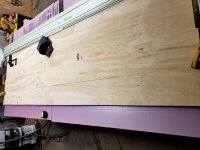WeekendWoodWerker
Member
- Joined
- Sep 28, 2019
- Messages
- 9
HI All,
New member to FOG, but I have been reading the posts for a long time. I ran into an issue today and just want to double check that I am not missing something simple. So here goes:
TS55 two 55 inch guides rails connected, confirm straightness as best I can using extruded piece that shows the back of each 55 rail is straight and is straight across the joint (back of rail as reference). Cutting 8ft length of half inch ply.
The cut is 7 inches wide. Using dewalt track clamps at both ends, and supporting the piece on rigid foam full 8ft length and width of workpiece all on top of a flat workbench.
I ripped a straight edge onto the factory ply removing about a kerf width from the edge. I then spin the guide rail around and reference the back of the rail to this straight edge at both ends using a digital caliper and double checking the splinter guard against measured marks at both ends.
I made the first cut and checked both ends were exactly 7 inches. I then made a second cut referencing off of the fresh edge of the previous cut using exactly the same process. Again, measurements at both ends exactly 7 inches. Great! However when I stacked the second cut on top of the first on the tack for storage I notice the boards are exactly the same width at the ends (feels perfectly flush to the fingertips), but they dont line up in the middle section. Indeed, after clamping one end to be perfectly flush, then adjusting the other end flush, it's an exact match at the ends, but as you move toward center they deviate by a few mm to either side. It's not just one board wider or narrower than the other in the center section (at least I dont think)
Several thoughts:
- belly in the guide rail, not straight?
- need to additionally clamp in the middle somehow, not just the ends?
- stress in the wood that released upon cut?
- somehow I torque the saw or rail or something in the middle of the cuts?
What could it be?
New member to FOG, but I have been reading the posts for a long time. I ran into an issue today and just want to double check that I am not missing something simple. So here goes:
TS55 two 55 inch guides rails connected, confirm straightness as best I can using extruded piece that shows the back of each 55 rail is straight and is straight across the joint (back of rail as reference). Cutting 8ft length of half inch ply.
The cut is 7 inches wide. Using dewalt track clamps at both ends, and supporting the piece on rigid foam full 8ft length and width of workpiece all on top of a flat workbench.
I ripped a straight edge onto the factory ply removing about a kerf width from the edge. I then spin the guide rail around and reference the back of the rail to this straight edge at both ends using a digital caliper and double checking the splinter guard against measured marks at both ends.
I made the first cut and checked both ends were exactly 7 inches. I then made a second cut referencing off of the fresh edge of the previous cut using exactly the same process. Again, measurements at both ends exactly 7 inches. Great! However when I stacked the second cut on top of the first on the tack for storage I notice the boards are exactly the same width at the ends (feels perfectly flush to the fingertips), but they dont line up in the middle section. Indeed, after clamping one end to be perfectly flush, then adjusting the other end flush, it's an exact match at the ends, but as you move toward center they deviate by a few mm to either side. It's not just one board wider or narrower than the other in the center section (at least I dont think)
Several thoughts:
- belly in the guide rail, not straight?
- need to additionally clamp in the middle somehow, not just the ends?
- stress in the wood that released upon cut?
- somehow I torque the saw or rail or something in the middle of the cuts?
What could it be?



